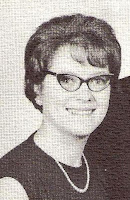My husband, upon reading about the eight generations I named
between our great granddaughter and my great, great, great grandfather Plucker,
said that I should do the same thing with the Thaden side of my family. So
here is another limb on Auri’s family tree.
My second cousin, Peggy Nelson has
gone to great lengths to follow the generations started in the mid-1650’s by
the ancestor of my grandfather, Eilert Ludwig Thaden, Tade Taden. The first two were named the same, but Peggy
assures us that they are father and son. Here is what I have put together –
with help from her impressive work on her own genealogy.
***
TADE TADEN
was born in Ardorf, Ostfriesland, Preussen in about 1650. There is no
information regarding who he married, but the records show that he was married
about 1676 in that same town. From that union, came:
TADE TADEN who was born in 1681 in his father’s home
town. He married Metke Johanssen [or] Janssen on June 1, 1707 in
Burhafe, Ostfriesland, Pruessen.
At
least one of their children was:
BRUNE OR BRUNO
TADEN who was born on February 14, 1713 [or] 1714 in Nevenbargen,
Burhafe, Osfriesland, Prussia. He married Fahlde Dirks in North Dunnum,
Dunum, Ostfriesland on June 22, 1741. He was 28 years old and his wife was 20.
From
this union, was born:
ETTE BRUNEN (or Bruns) THADEN (daughter of Bruno Thaden) who was born on July 28, 1747 in North Dunum,
Ostfriesland. She married Thade Hinrichs Wilken , the records say “bef.
1769” in Ostfriesland, Prussia.
They
named their child:
THADE MAMMEN THADEN who was born on January 17, 1790 in
North Dunum, Ostfriesland. He married Teelke Margareta Weerts [or] Stindt
on May 18, 1816 in North Dunum.
When Thade
was 46 and Teelke was 41, at least one of their children was:
GERD LUKEN THADEN
who was born on August 18, 1836 in Willen, Germany. He married Johanna
Christina Amelia Wilken on October 27, 1859 in Essens, Germany. She was
born in Aurich, Hannover, Germany.
 |
I've been told that the men in this car are Thadens and/or Buus's.
Therefore, I will surmise that the fellow in the front, on the left, is Gerhard Ludwig. |
Gerd (My grandfather identified his father as Gerhardt Ludwig) and Johanna left their
home in Aurich (where he was a teacher and Johanna was a music teacher) to come
to America. They eventually moved to Peoria, Illinois where my grandfather was
born. When my grandfather was an infant, they moved to Grundy County, Iowa and
later to Luverne, Minnesota before moving on to Tacoma, Washington in 1891 –
again as farmers. He died in 1910 when he was 74. She died in 1924 when she was
65. They were both buried in Tacoma.
The Thadens
were blessed with eight children, one of whom was:
EILERT LUDWIG
THADEN who was born on May 25, 1870 in Peoria, Illinois. He married Harmina
Buus on March 11, 1897 who he met when he was working on a farm near
Lennox, South Dakota. [Eilert’s story was the first posted on this blog in
March, 2011.]They were married on March 11, 1897 in Lennox, South Dakota. They
lived at Chancellor, SD until 1903 when they moved to Bryant, SD and later
bought a farm south of Willow Lake, where they lived until 1943 when they moved
into town.
 |
Louie & Minnie's
wedding picture |
 |
Louie & Minnie's
50th Wedding Anniversary
1947 |
On September 8, 1949 Minnie died at age 71 and Eilert lived
alone for 13 years and died on December 19, 1962 at the age of 92 years, 6
months and 24 days.
Eleven children were born to this union between 1898 and
1917. Their middle child:
 |
| Dena in 1969 |
HENDINA MAREGARITA
THADEN was born on October 29, 1902 on a farm near Chancellor, South
Dakota. She married Menne Elvin (M.E.J. Plucker on June 4, 1924 in
Bryant, SD. She became known as Dena Margaret Plucker and carried the music
gene forward from her grandmother, Johanna. She took two years of nurse’s
training before my father convinced her to marry him.
They were parents of three children: Dorothy June, Robert
Elvin and
 |
| Jean in 2011 |
JEAN ELLEN PLUCKER STRAATMEYER, who
was born on November 25, 1938 on a farm near Chancellor, South Dakota and married Henry Gene Straatmeyer on June
11, 1957.
Three
children were born to this union: Cynthia Jean,
Sandra
Jean and Michael Gene.
 |
| Cindee in 2005 |
CYNTHIA JEAN STRAATMEYER KARNS was
born on April 25, 1959 in Rock Rapids, Iowa. She married Curtis Edwin Karns on June 5, 1981.
To this
union were born two children: Kirsten Jean, and Keith Thomas.
KIRSTEN JEAN KARNS, born on August 29, 1983 in Fairbanks, Alaska, married Daniel Leonard on December 29, 2006.
Shortly after their marriage, they both changed their names to
Daniel Neilsen Leonard Talbot and
JEANIE KARNS TALBOT.
 |
| Jeanie in 2006 |
Their first baby was born on June 25, 2012 in Fairbanks, Alaska and named:
AURELIA ELEANOR TALBOT
 |
| Auri in 2012 |
THIS BRINGS THE THADEN GENERATION COUNT TO ELEVEN – EVEN THOUGH
THE THADEN NAME ONLY FOLLOWS THROUGH AS FAR AS MY MOTHER, DENA.




























,+Dots+(11.5).JPG)


















